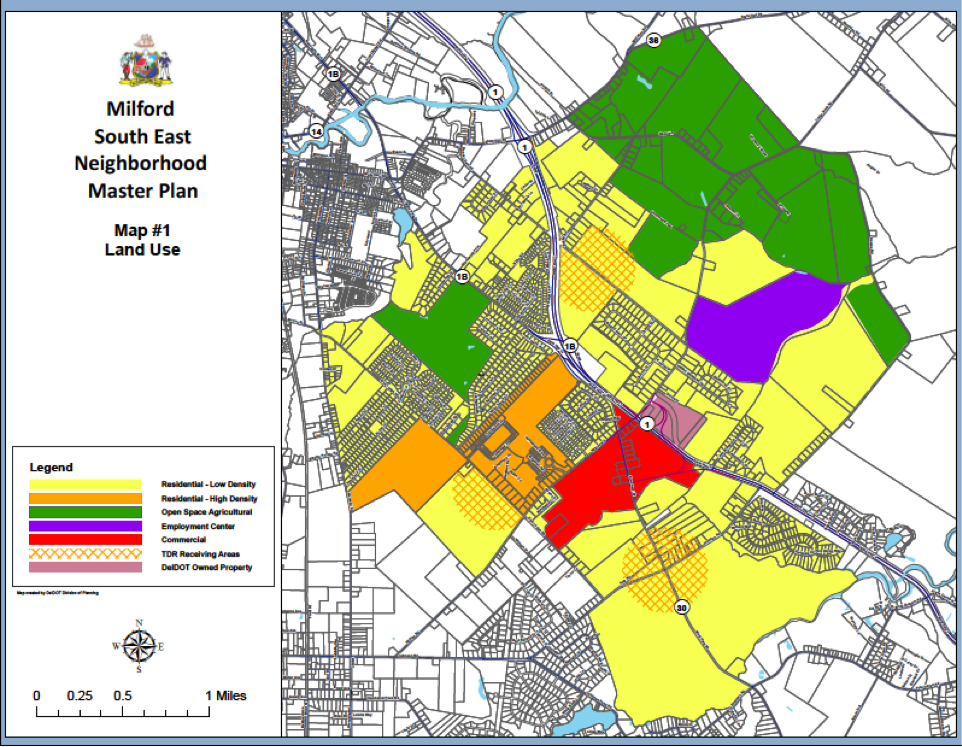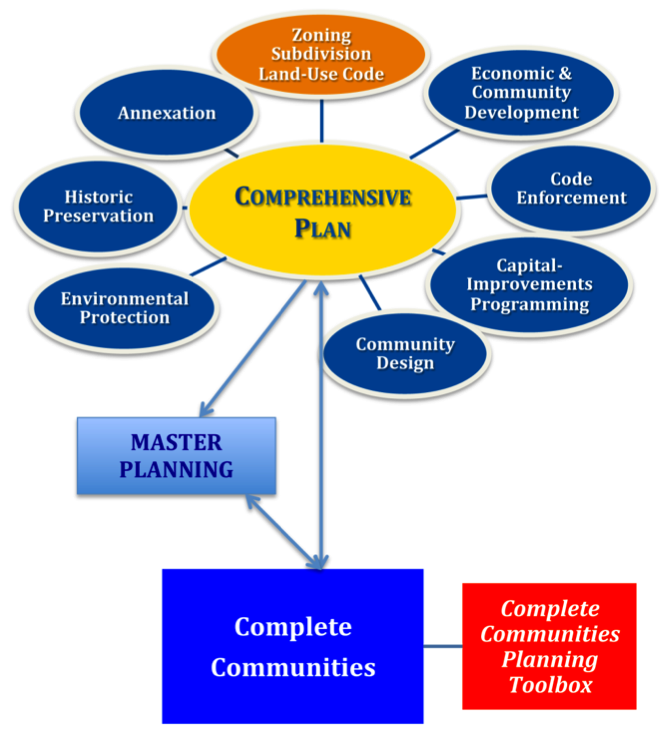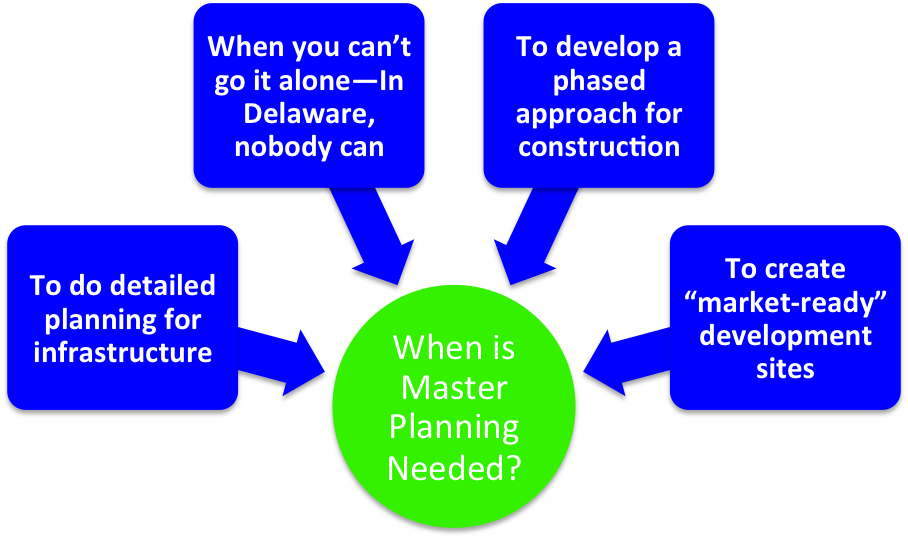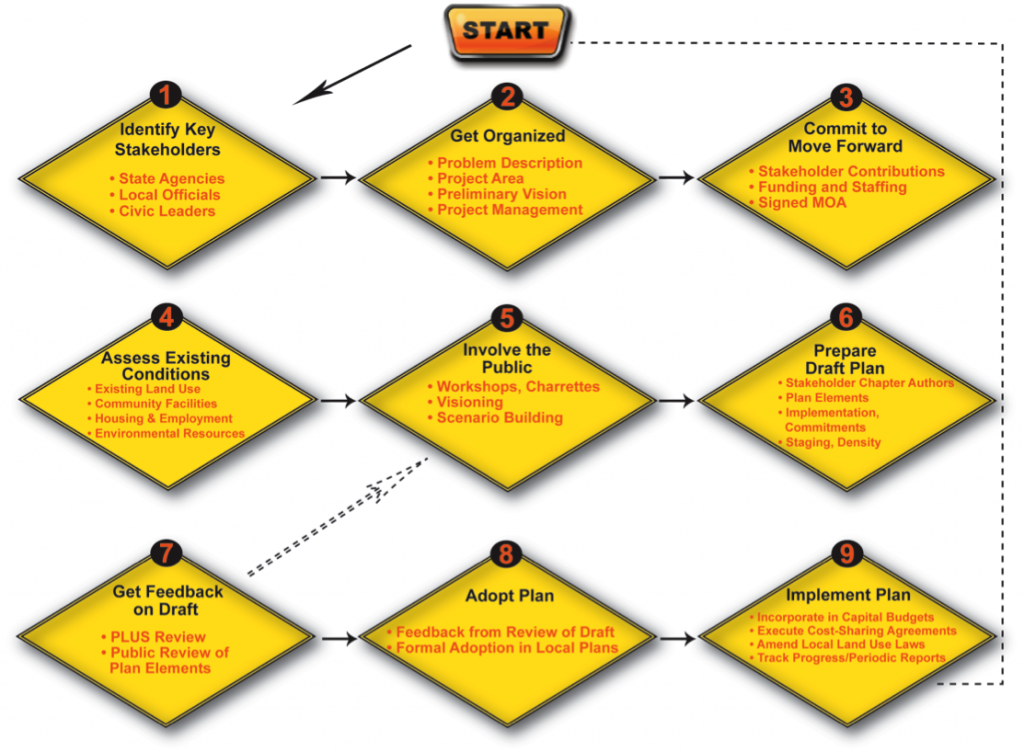 Introduction
Introduction
Master Planning is not a new concept in Delaware. It is somewhat in retrospect that the term “Master Planning” has been tagged to such efforts. It’s been going on for a while, but the projects were just not called “master plans.”
Master Planning is an integral component of the Complete Communities framework. It complements and integrates other planning activities. Local comprehensive plans articulate visions and formulate general guidelines for achieving desired land use patterns in counties and municipalities. Master Planning brings all stakeholders—state agencies, local governments, civic groups, and business leaders—together to “get it done” by spelling out the details of, and the responsibilities for, the provision of infrastructure services in an efficient, timely, and cost-effective manner.
In September 2012, the Office of State Planning Coordination introduced the Guide for Master Planning in Delaware. This document is a reference for developing and adopting master plans, and it describes several completed and ongoing master planning projects throughout the state.
Topics covered below include:
- What Is a Master Plan?
- How Does Master Planning Fit in with Local Comprehensive Plans?
- When Do You Need a Master Plan?
- How to Do a Master Plan in Nine Easy Steps
- Where Is Master Planning Taking Place in Delaware?
- No Two Plans are Alike
- Master Planning Resources
What Is a Master Plan?
Drawing heavily on the American Planning Association’s APA Planners Dictionary, as amended by the Delaware Office of State Planning Coordination, the Guide defines master planning as follows.
A master plan is a land use plan focused on one or more sites within an area that identifies access, general improvements and needed infrastructure, and intended to guide growth and development over a number of years and in phases.
How Does Master Planning Fit in with Local Comprehensive Plans?
Local Comprehensive Plans
- Cover a single county or municipality.
- Consist of required elements specified in Title 9, Chapter 48 (counties) and Title 22, § 702 (municipalities) of the Delaware Code.
- Articulate visions for the future.
- Provide guidelines for growth and development
- Require periodic review and update.
- Often use Complete Communities principles to formulate guiding principles for growth and development.
Master Plans
- Bring together all stakeholders—state agencies, local governments, civic groups, and business leaders.
- Involve significant public engagement often with interactive techniques.
- Are not constrained by municipal or county boundaries.
- Are more detailed than comprehensive plans, and include items such as:
- Build-out calculations—number of homes, square footage of offices and retail stores
- Infrastructure needs and costs—road improvements, water and sewer extensions
- Phasing and coordination of infrastructure provision with development.
- Include commitments from infrastructure and service providers that facilities will be funded and in place when needed.
- Utilize complete community elements for infrastructure design, density, types and mix of land uses, open space, and recreation.
When Do You Need a Master Plan?
Here are some specific situations that might set a master planning process in motion.
- While updating a comprehensive plan, a town planner realizes that in order to annex a property adjacent to the town, an extension to the county sewer is needed.
- A developer presents a concept for a traditional neighborhood development that includes properties in a municipality and an adjacent county.
- A proposal for infill development requires improvements to streets and roads not controlled by the town.
- Your town has annexed a 200-acre parcel adjacent to a major highway and wants to make the site shovel-ready for economic development.
- A major employer, who is also a large-water user, announces plans to triple its workforce over the next five years.
How to Do a Master Plan in Nine Easy Steps
Pages 4 – 14 of the Guide outlines nine steps to help direct master plan efforts.
Example Step
Each of the nine steps is further described, and recommendations are made for utilizing them to create master plans. Below is an example from the Guide using “Step 3 Commit to Move Forward” to demonstrate typical organization and content.
|
Step 3. Commit To Move Forward All Master Plans should have a signed Memorandum of Agreement (MOA). A signed MOA demonstrates commitment by the stakeholders to participate in the effort and assume their responsibilities in the implementation of the plan’s recommendations. The following list recommends elements that an MOA document should include.
|
Where Is Master Planning Taking Place in Delaware?
Master Planning is going on all over the state, and these plans come in a variety of sizes, shapes, and scope. Some plans are completely in one jurisdiction while others span a municipal boundary into parts of the adjoining county.
Pages 15 through 41 of the Guide chronicle how the nine steps were applied to the development and implementation of the six plans identified on the map. The information for this section is based on extensive interviews with participants in the development of these plans. It also includes a list of “Lessons Learned.”
No Two Plans are Alike
Perhaps the most important “lesson learned” is that the Guide for Master Planning in Delaware is just that—a guide, a reference, a recommended course of action. For example, the Guide says that all master plans should have a signed memorandum of understanding (MOA), but the table below shows how the commitment to move forward varied among the six master plans. Some of the plans without a formal MOA have proven no less successful than those without it.
| Master Plan Area | Application of Step 3. Commit to Move Forward |
| Churchman’s Crossing | A formal MOA was not executed for this project. |
| Westown | There was no formal agreement or MOA as part of the review process for this project. |
| Eden Hill | The commitment to move forward clearly came from the results of a series of workshops held by the City of Dover in conjunction with the comprehensive plans of 1996, 2003, and 2008. |
| Southern New Castle County Infrastructure | An MOA was deemed essential for this project. Accordingly, its signatories included the major governmental land use decision-makers. New Castle County was named as the lead agency for project management. |
| Milford Southeast Neighborhood | …an MOA was considered essential. In 2008 the City of Milford, OSPC, DelDOT, and DDA signed an MOA. As the plan progressed, DNREC, DSHA, and the State Historic Preservation Office (SHPO) became partners… |
| Georgetown South | Considerable effort was made to develop an MOA for this work. A working draft was developed, but it was not agreed to by the group and thus was not signed. Opinions differed on the need for the MOA… |
Master Planning Resources
Want to Know More about Master Planning in Delaware?
- Download the FREE Guide for Master Planning in Delaware.
- Sign up to take Delaware Planning Education Program courses through the Institute for Public Administration. Upcoming trainings are listed on the IPA events page.
- Contact the Office of State Planning Coordination (OSPC) at (302) 739-3090 to obtain planning assistance. OSPC staff work to improve the coordination and effectiveness of land use decisions made by state, county, and municipal governments while building and maintaining a high quality of life in the State of Delaware.





